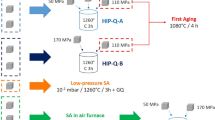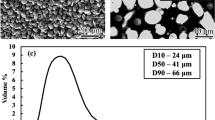Abstract
An Al-Ni alloy system with excellent energy density and mechanical performance is regarded as a novel high-energy–density material to enhance the energy emission of explosives or propellants. In this study, we explored the influence of a process control agent (PCA) varying from 0, 0.1, 0.25, 0.5, to 1.0 (wt.%) on the cryomilling of Al and Ni powder mixtures. The structural and morphological evolution of cryomilled Al-Ni powder was determined by X-ray diffraction, scanning electron microscopy, particle size distribution analysis, and transmission electron microscopy. Differential thermal analysis was used to study the exothermic reaction temperature, and activation energy calculations were performed using Kissinger plots. The results indicated that the addition of PCA changed the Al-Ni aggregate shape from oval to granular. The lamellar size also became finer after adding PCA up to 0.25 wt.% but the lamellar shape changed to granular at 1 wt.% PCA. These nanoscale lamellae serve as nuclei to produce Al-Ni reaction compounds, which gradually decrease the activation energy. The optimal concentration of PCA was determined to be 0.25 wt.% as this concentration decreased the activation energy of the Al-Ni alloy because of the fine, homogeneous, and alternate Al-Ni lamellae in the alloy when cryomilled.





Similar content being viewed by others
Data availability
The data generated in this work cannot be shared at this time as it is a part of ongoing project which is treated as confidential.
References
Floro JA (1986) Propagation of explosive crystallization in thin Rh-Si multilayer films. J Vac Sci Technol 4:631–637
Gavens AJ, Heerden DV, Mann AB et al (2000) Effect of intermixing on self-propagating reactions in Al/Ni nanolaminate foils. J Appl Phys 87:1255–1263
Mann AB, Gavens AJ, Reiss ME et al (1997) Modeling and characterizing the propagation velocity of exothermic reactions in multilayer foils. J Appl Phys 82:1178–1188
Adams DP (2015) Reactive multilayers fabricated by vapor deposition: a critical review. Thin Solid Films 576:98–128
Rogachev AS, Mukasyan AS (2010) Combustion of heterogeneous nanostructural systems (review). Combust Explos Shock Waves 46:243–266
Hastings DL, Dreizin EL (2018) Reactive structural materials: preparation and characterization. Adv Eng Mater 20:1700631
Ovid’ko IA, Valiev, RZ, Zhu, YT, (2018) Review on superior strength and enhanced ductility of metallic nanomaterials. Prog Mater Sci 94:462–540
Zhu P, Li JCM, Liu CT (2002) Reaction mechanism of combustion synthesis of NiAl. Mater Sci Eng A 329–331:57–68
Mason BA, Sippel TR, Groven LJ et al (2015) Combustion of mechanically activated Ni/Al reactive composites with microstructural refinement tailored using two-step milling. Intermetallics 66:88–95
Mason BA, Groven LJ, Son SF (2013) The role of microstructure refinement on the impact ignition and combustion behavior of mechanically activated Ni/Al reactive composites. J Appl Phys 114:113501
Manukyan KV, Tan W, Deboer RJ et al (2015) Irradiation-enhanced reactivity of multilayer Al/Ni nanomaterials. ACS Appl Mater Interfaces 7:11272–11279
Sraj I, Specht PE, Thadhani NN et al (2014) Numerical simulation of shock initiation of Ni/Al multilayered composites. J Appl Phys 115:023515
Gibbins JD, Stover AK, Krywopusk NM et al (2015) Properties of reactive Al: Ni compacts fabricated by radial forging of elemental and alloy powders. Combust Flame 162:4408–4416
Suryanarayana C (2001) Mechanical alloying and milling. Prog Mater Sci 46:1–184
Duckham A, Spey SJ, Wang J et al (2004) Reactive nanostructured foil used as a heat source for joining titanium. J Appl Phys 96:2336–2342
Noro J, Ramos AS, Vieira MT (2008) Intermetallic phase formation in nanometric Ni/Al multilayer thin films. Intermetallics 16:1061–1065
Andrzejak TA, Shafirovich E, Varma A (2007) Ignition mechanism of nickel-coated aluminum particles. Combust Flame 150:60–70
Oh M, Oh MC, Han D et al (2018) Exothermic reaction kinetics in high energy density Al-Ni with nanoscale multilayers synthesized by cryomilling. Metals 8:121
Sun F, Rojas P, Zúñiga EJ (2006) Nanostructure in a Ti alloy processed using a cryomilling technique. Mater Sci Eng A 430:90–97
Yazdani N, Toroghinejad MR, Shabani A et al (2021) Effects of process control agent amount, milling time, and annealing heat treatment on the microstructure of AlCrCuFeNi high-entropy alloy synthesized through mechanical alloying. Metals 11:1493
Lu L, Zhang YF (1999) Influence of process control agent on interdiffusion between Al and Mg during mechanical alloying. J Alloy Compd 290:279–283
Zhang YF, Lu Lu, Yap SM (1999) Prediction of the amount of PCA for mechanical milling. J Mater Proc Technol 89–90:260–265
Long BD, Zuhailawati H, Umemoto M et al (2010) Effect of ethanol on the formation and properties of a Cu–NbC composite. J Alloy Compd 503:228–232
Sharma A, Lee H, Ahn B (2021) Microstructure and properties of in-situ Al–Si/Al2O3 composites prepared by displacement reaction. Powd Met 64:192–197
Pilar M, Escoda L, Sunol JJ et al (2008) Magnetic study and thermal analysis of a metastable Fe–Zr-based alloy: influence of process control agents. J Magn Magn Mater 320:e823–e827
Neamţu BV, Isnard O, Chicinaş I et al (2011) Structural and magnetic properties of nanocrystalline NiFeCuMo powders produced by wet mechanical alloying. J Alloy Compd 509:3632–3637
Pilar M, Sunol JJ, Bonastre J et al (2007) Influence of process control agents in the development of a metastable Fe–Zr based alloy. J Non-Cryst Solids 353:848–850
Lee W, Kwun SI (1996) The effects of process control agents on mechanical alloying mechanisms in the Ti–Al system. J Alloys Compd 240:193–199
Gheisaria K, Javadpourb S (2013) The effect of process control agent on the structure and magnetic properties of nanocrystalline mechanically alloyed Fe–45% Ni powders. J Magn Magn Mater 343:133–137
Manukyan KV, Mason BA, Groven LJ, Lin YC, Cherukara M, Son SF, Strachan A, Mukasyan AS (2012) Tailored reactivity of Ni–Al nanocomposites: microstructural correlations. J Phys Chem C 116(39):21027–21038
Simo˜es S, Viana F, Ramos AS, Vieira MT, Vieira MF, (2011) Anisothermal solid-state reactions of Ni/Al nanometric multilayers. Intermetallics 19(3):350–356
Blaine RL, Kissinger HE (2012) Homer Kissinger and the Kissinger equation. Thermochim Acta 540:1–6
Huang BL, Vallone J, Luton MJ (1995) Formation of nanocrystalline B2 NiAl through cryomilling of Ni-50 at. % Al at 87 K. Nanostruct Mater 5:411–424
Rocha CJ, Araújo RMLN, Goncales VS et al (2003) An investigation of the use of stearic acid as a process control agent in high energy ball milling of Nb-Al and Ni-Al powder mixtures. Mat Sic Forum 299–300:457
Koch CC (2002) Nanostructured materials: processing, properties and potential applications. William Andrew Publishing, Norwich
White JD, Reeves RV, Son SF et al (2009) Thermal explosion in Al-Ni system: influence of mechanical activation. J Phys Chem A 113:13541–13547
Lagoviyer OS, Schoenitz M, Dreizin EL (2018) Effect of milling temperature on structure and reactivity of Al-Ni composites. J Mater Sci 53:1178–1190
Christopher ES, Alexander SM (2017) Reactive Ni/Al nanocomposites: structural characteristics and activation energy. J Phys Chem A 121:1175–1181
Shteinberg AS, Lin YC, Son SF, Mukasyan AS (2020) Kinetics of high temperature reaction in Ni-Al system: influence of mechanical activation. J Phys Chem A 114:6111–6116
White JDE, Reeves RV, Son SF, Mukasyan AS (2009) Thermal explosion in Al-Ni system: influence of mechanical activation. J Phys Chem A 113:13541–13547
Lagoviyer OS, Schoenitz M, Dreizin EL (2018) Effect of milling temperature on structure and reactivity of Al–Ni composites. J Mater Sci 53:1178–1190
Manukyan KV, Mason BA, Groven LJ, Lin YC, Cherukara M, Son SF, Strachan A, Mukasyan AS (2012) Tailored reactivity of Ni+Al nanocomposites: microstructural correlations. J Phys Chem C 116:21027–21038
Reeves RV, Mukasyan AS, Son SF (2010) Thermal and impact reaction initiation in Ni/Al heterogeneous reactive systems. J Phys Chem C 114:14772–14780
Manukyan KV, Mason BA, Groven LJ et al (2012) Tailored reactivity of Ni + Al nanocomposites: microstructural correlations. J Phys Chem C 116:21027–21038
Acknowledgements
This work was supported by a National Research Foundation of Korea (NRF) grant funded by the Korean government (MSIT) (No. 2021R1A2C1005478) and (No. 2021R1A4A1031357). The authors would like to thank Mr. Minseok Oh for helping with the experiment.
Author information
Authors and Affiliations
Corresponding author
Ethics declarations
Conflict of interest
The authors declare that there are no conflicts of interests regarding the publication of this manuscript.
Additional information
Handling Editor: M. Grant Norton
Publisher's Note
Springer Nature remains neutral with regard to jurisdictional claims in published maps and institutional affiliations.
Rights and permissions
About this article
Cite this article
Sharma, A., Lee, H. & Ahn, B. Microstructure and reactivity of cryomilled Al-Ni energetic material with nanoscale lamellar structure. J Mater Sci 57, 17957–17966 (2022). https://doi.org/10.1007/s10853-022-07429-9
Received:
Accepted:
Published:
Issue Date:
DOI: https://doi.org/10.1007/s10853-022-07429-9




